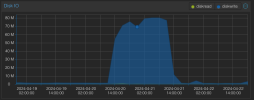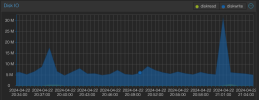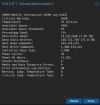Just wondering - I have a small cluster of 5 nodes running various stuff - one node is an R86s (N5105) device running OPNSense as router - been working fine for many months now . . . but I noticed a problem recently which turned out to be the netflow monitor going nuts - I was experiencing extremely high disk io writes up to 80M. After resetting the netflow, things settled down again - but now I am averaging around 5M - I think because I use ZenArmor and NTopNG which does a bunch of statistics and logging
My question is: What is considered "normal" when it comes to io writes and when should I worry about nvme ssd excessive wear ? I don't necessarily need the NTopNG running constantly, which when turned off reduces the normal io writes down to 1.5M on average
Any best practice tips would be welcome!!
Here was the anomoly which I corrected by resetting the netflow data:

and here is the average now with NTopNG running:

My question is: What is considered "normal" when it comes to io writes and when should I worry about nvme ssd excessive wear ? I don't necessarily need the NTopNG running constantly, which when turned off reduces the normal io writes down to 1.5M on average
Any best practice tips would be welcome!!
Here was the anomoly which I corrected by resetting the netflow data:

and here is the average now with NTopNG running:





